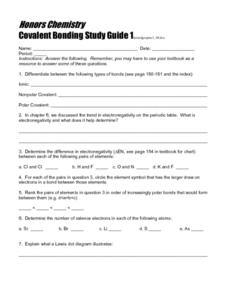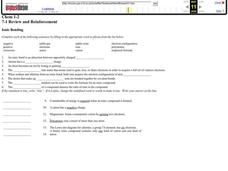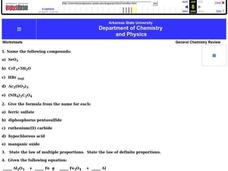Curated OER
Regents High School Examination PHYSICAL SETTING CHEMISTRY 2007
The University of the State of New York has designed a series of exams to be given to high schoolers. This chemistry exam is one of the most comprehensive and well-written that you will ever find. It consists of 84 questions in a variety...
Curated OER
Honors Chemistry-Covalent Bonding Study Guide I
In this covalent bonding activity, learners answer questions about types of bonds, electronegativity, valence electrons, and Lewis dot structures. They answer specific questions about covalent bonds in molecules and explain the...
Curated OER
IPC Chemistry Review
In this chemistry review worksheet, students classify and name compounds, calculate atomic mass, draw Lewis Dot Diagrams, and determine number of protons for atoms. This worksheet has 37 fill in the blank, 38 matching, and 3 short answer...
Curated OER
Ranking Molecular Properties Based Upon Intermolecular Forces
A splendid chart of information about chemical bonding tops the first page. In it you will find information on London forces, permanent dipoles, hydrogen bonds, ionic bonds, and covalent bonds. A four-step process for assigning...
Curated OER
Lewis Dot Structures
In this Lewis dot structure learning exercise, students draw the Lewis dot structure and give the electron arrangement and molecular geometry for 27 chemical compounds.
Curated OER
VSEPR And Polarity
In this VSEPR theory worksheet, students evaluate the electron-pair geometry of organic and inorganic molecules. They construct Lewis structures and resonance structures for 17 compounds and complete 3 short answer questions.
Curated OER
Predicting Molecular Geometry and Hybridization
In this molecular geometry and hybridization learning exercise, students identify bond angles, Lewis structures, hybridization, polarity and valance electrons in given molecules. They also label a drawn compound with hybridization and...
Curated OER
Biochemistry Assignment
In this biochemistry worksheet, students complete a table by filling in the missing information about different elements. Students draw the Bohr diagram and the Lewis dot diagram for several atoms.
Curated OER
Periodic Table Basics 2
For this periodic table worksheet, learners create cards for a annotated periodic table then use it to answer 16 short answer and fill in the blank questions.
Curated OER
Ionic Bonding
In this ionic bonding worksheet, high schoolers review the characteristics of ionic bonding, draw Lewis dot diagrams for elements, and write the chemical formula for ionic compounds. This worksheet has 8 drawings, 14 fill in the blank,...
Curated OER
Chemical Compounds
In this chemical compounds worksheet, students write the name of compounds from their chemical formula, balance equations, write electronic configurations for elements, and draw Lewis dot structures. This worksheet has 8 fill in the...
Curated OER
Oxidation Numbers
In this oxidation numbers worksheet, students compare metals and nonmetals, draw Lewis Dot Diagrams, and determine the oxidation number for the given elements. This worksheet has 1 multiple choice, 5 short answer, and 12 fill in the...
Curated OER
Intermolecular Forces
In this compounds instructional activity, students identify the main intermolecular force in the given compounds and explain the differences between dipole-dipole forces and hydrogen bonds. This instructional activity has 5 short answer...
Curated OER
Solubility
In this solubility worksheet, students determine which solute will be more soluble in the solvent listed. Students complete 7 matching and 3 problems to solve.
Curated OER
Compounds
In this compounds activity, students draw the Lewis dot structure for given compounds plus determine the electron geometry, type of hybrid, molecular geometry, polarity, and number of sigma and pi bonds. This activity has 5 fill in the...
Curated OER
Chemistry 130
In this chemical compounds worksheet, students calculate moles, molar concentration, and volume of given compounds. Students balance equations, give the formula and charge of polyatomic ions, and draw Lewis electron dot structures. This...
Curated OER
Elements and Molecules
In this elements worksheet, students write the electron configuration, structural formula, or Lewis electron dot structure of given elements and compounds. This worksheet has 8 fill in the blank and 3 drawings.
Curated OER
Organic Chemistry Problem Set Exam 1
Though there are technically only 13 questions on this exam, they take up six pages and make a thorough assessment of organic chemistry principles. There are plenty of diagrams to label or complete. Emission spectra are displayed for...
Curated OER
Creating Bonds
In this creating bonds worksheet, students create 2-D and 3-D models of the molecular formula provided. Students complete a chart of information about the molecular formula given.
Curated OER
Finding Oxidation States
In this chemistry worksheet, learners examine the oxidation state in order to apply it in the laboratory setting. The sheet includes in depth background information.
Curated OER
Chemical Bonding and Shapes of Molecules
In this chemical bonds worksheet, students review the different types of bonds, Lewis dot structures, ions, and molecule shapes. This worksheet has 10 matching, 17 multiple choice, and 3 drawing questions.
Curated OER
Chemistry 151 - Final Review
In this chemistry review worksheet, students give atomic symbols for given atoms, calculate moles, determine empirical formulas, and balance chemical equations. This worksheet has 1 drawing, 9 fill in the blank, and 12 word problems.
Curated OER
Review Questions-Molecular Geometry and VSEPR Theory
In this molecular geometry and VSEPR learning exercise, students find bond angles, hybridization, determine polarity and draw orbital box diagrams of molecules. They determine molecular geometry and bond angles of given molecules and...
Curated OER
Intermolecular Forces Worksheet
In this intermolecular forces worksheet, high schoolers answer 4 questions about the forces between atoms within molecules and compounds. Students rank the boiling points of compounds based on their intermolecular forces and they explain...























